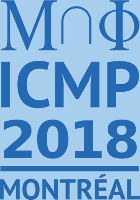Probability & Random Matrices
- Louigi Addario-Berry (McGill University)
- Yan Fyodorov (King's College London)
- Monday, Jul 23 [mont royal i & ii]
- 15:15 Antonio Auffinger (Northwestern University), No presentation title available
- 15:45 Margherita Disertori (Institut für Angewandte Mathematik & Hausdorff Center for Mathematics), Random matrices and history dependent stochastic processes
- Tuesday, Jul 24 [mont royal i & ii]
- 14:00 Ron Peled (Tel Aviv University), A power-law upper bound on the correlations in the two-dimensional random-field Ising model
- 14:30 Dana Randall (Georgia Institute of Technology), Phase transitions in programmable active matter
- 15:00 Tatyana Shcherbyna (Princeton University), Transfer matrix approach to 1d random band matrices
- 15:30 Christian Webb (Aalto University), Applications of Gaussian multiplicative chaos
- Margherita Disertori
Institut für Angewandte Mathematik & Hausdorff Center for MathematicsRandom matrices and history dependent stochastic processesIn recent years unexpected connections have been discovered between lattice random Schrödinger operators and certain history dependent stochastic processes. I will give an overview and some recent results.
- Ron Peled
Tel Aviv UniversityA power-law upper bound on the correlations in the two-dimensional random-field Ising modelAs an example of the Imry-Ma phenomenon, the addition of an iid quenched random field to the two-dimensional Ising model eliminates the model's famed discontinuity in its magnetization's response to a uniform external field. Thus, even with a weak random field, the 2D Ising model has a unique infinite-volume Gibbs state at all temperatures. This fact may be quantified by considering the decay rate of the effect of boundary conditions on the magnetization in finite systems. This rate is known to be exponentially fast for a strong random field. Our main new result is a power-law upper bound which is valid at all field strengths and at all temperatures, including zero. Our analysis proceeds through a streamlined and quantified version of the Aizenman-Wehr proof of the Imry-Ma rounding effect.
Joint work with Michael Aizenman.
- Dana Randall
Georgia Institute of TechnologyPhase transitions in programmable active matterWe consider stochastic solutions to problems arising from programmable active matter based on emergent phenomena. We view active matter as a collection of simple computational elements (or particles) with limited memory that self-organize to solve system-wide problems of movement, configuration, and coordination. First, we present a solution to the compression problem, which aims to have the particle system gather as tightly together as possible through a distributed, local, and asynchronous algorithms. We assume the geometric amoebot model and show that we can achieve compression whenever we start with a particle system that is simply connected. We also present a stochastic solution to the separation problem, in which heterogenous (colored) particles interact initially without bias, but separate into homogeneous clusters in the presence of new environmental conditions. - Tatyana Shcherbyna
Princeton UniversityTransfer matrix approach to 1d random band matricesRandom band matrices (RBM) are natural intermediate models to study eigenvalue statistics and quantum propagation in disordered systems, since they interpolate between mean-field type Wigner matrices and random Schrodinger operators. In particular, RBM can be used to model the Anderson metal-insulator phase transition (crossover) even in 1d. In this talk we will discuss some recent progress in application of the supersymmetric method (SUSY) and transfer matrix approach to the analysis of local spectral characteristics of some specific types of RBM.
- Christian Webb
Aalto UniversityApplications of Gaussian multiplicative chaosI will discuss how a class of random generalized functions and random measures known as Gaussian multiplicative chaos appears naturally in models of random matrix theory, probabilistic number theory, and critical lattice models, and how such results can be applied.


